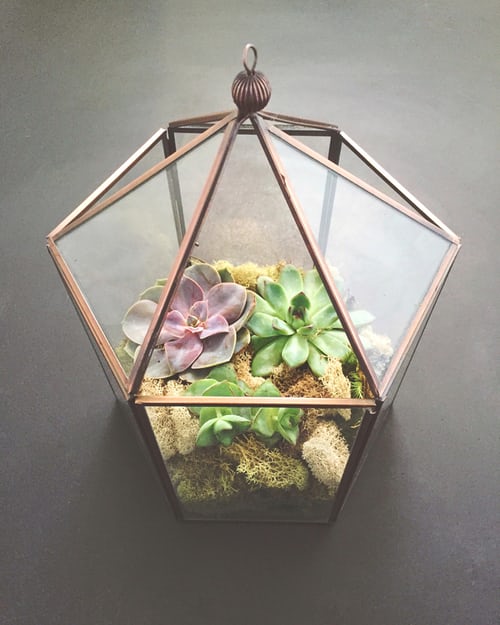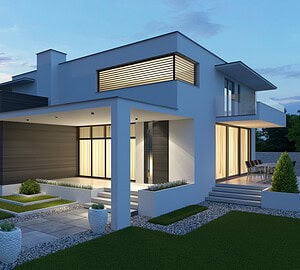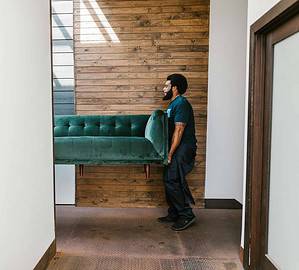
There‘s nothing quite like nature to soothe the soul, unwind the mind, and provide a welcome break from the fast pace of modern life. Whether it’s lying on the grass, feeling the warmth of the sun on your face or enjoying the melodious sounds of the birds over your morning cup of coffee, the natural elements work wonders to reduce our stress, stimulate our creativity and bring peace to our minds.
When it comes to decorating your home, plants are a great way to brighten up your world by bringing greenery, freshness and an aesthetic appeal to your indoor environment. Mother Nature not only provides a unique sense of beauty and style to your home but therapeutic benefits too as studies have found that bringing plants into your home or office can help make you feel more soothed, comfortable and natural.
If you would like to add your creativity as well as a touch of the outdoors to your home, then read on for some ways to incorporate nature into your home décor with your very own terrarium.
What Is a Terrarium?
A terrarium can be thought of as a miniature indoor garden housed inside a sealed container. These miniature, self-sustaining ecosystems are much like greenhouses that allow plants to self-nourish with little to no maintenance.
The water vapor released from the plants and the soil becomes water droplets which form on the inside of the container. This water is essentially recycled, as just like rainfall it will drip back into the soil and be absorbed by the plants through their roots.
These charming, botanical creations are easy to maintain and can bring a fresh and inspiring look to your interior design. Whether it’s a fun project to do with the children, a coffee table centerpiece or your very own terrarium table to liven up your living room and showcase your creativity, there is no better way to beautify a room than by making your very own terrarium.
Make Your Own Terrarium
It’s important to choose plants that are suitable for the miniature climate within your terrarium. Ideally, moisture-loving plants that enjoy humid conditions are best. Some examples include:
- Ferns and mosses –Button ferns and Bryophytes
- Nerve plants – Fittonia, Juanita
- Succulents- Pincushion cactus, Jade plant
- Carnivorous plants – Tropical Pitchers, Sundews, Venus flytraps
- Airplants – Tillandsia stricta
Terrarium Supplies
You can gather all the supplies you’ll need to make your DIY terrarium by visiting your local garden center. You’ll need the following items:
- A glass or clear plastic container – A transparent, colorless container that allows for optimum light penetration is best. The shape and size of your container will depend on the purpose of your terrarium. A small centerpiece for your desk will not require a big container, whereas something more functional, such as a table will.
- Plants
- Soil – To avoid disease, choose a sterilized soil that offers adequate moisture retention. Peat moss or houseplant soil are good options.
- Gravel or activated charcoal
- Tools – A spoon and tweezers
- Decorative items – Ideas include shells, moss, twigs, driftwood or gemstones.
Build Your Terrarium
- Thoroughly wash your container with hot, soapy water and allow it to dry completely
- Add your layer of gravel or activated charcoal to the container which will act as a drainage layer and should be 2 to 5 centimeters thick
- Put the soil in next, patting it down with your hands or a spoon, creating a layer which is 5 to 10 centimeters thick
- Dig some holes into the soil to place your plants making sure their roots are properly covered
- Place your decorations last
- Lightly water your terrarium using a small jug or pipette, being careful not to over-water it. Seal the container closed
Place your terrarium somewhere it will receive natural light, making sure to avoid direct sunlight. It will not need watering as much as other indoor plants as it recycles water, however, a light spritz every two weeks or so should be enough. If you notice the container has fog or condensation on it this could signal too much water.
Maintenance Tips
Although they are low-maintenance, these natural creations do require some attention to maintain an optimum environment for your plants. The following tips can help you to care for your terrarium and ensure your indoor garden is thriving.
Discard Dead or Decomposing Material
Look out for any diseased or decomposing material within your terrarium, making sure to remove it quickly to prevent it from contaminating the rest of the plants. If left inside, any decaying or dead vegetation will end up rotting and can create a smelly and poor environment for your plants.
Clean the Container
If your container becomes too dirty it will make it more difficult for light to penetrate and reach your plants. Use a damp cloth to give the interior and exterior a clean every so often making sure to avoid any chemicals or cleaning products that could harm your plants.
Enough Light
While direct sunlight can be damaging to your plants, a lack of natural light can also cause problems. Ideally, your terrarium should get four to six hours of indirect sunlight per day. If you are growing a terrarium during the winter months when there may be insufficient light you can supplement this with artificial lighting such as fluorescent or LED lighting.
Not too Hot
When choosing a location for your terrarium avoid putting it too close to a heating source such as a radiator as this can kill the plants inside.
Overgrowth
Keep your plants’ growth in check by pruning them when they get too big and interfere with each other or your ability to admire the contents of your terrarium. Overcrowding can also cause leaves to push against the surface of the container and attract condensation which may lead to mold or fungus on your plants.
Regular pruning will keep your terrarium healthy as well as visually appealing.
Why not wow your guests with your creative designs or offer them as gifts to friends and family? With these tips, you are well on your way to creating your first terrarium.



